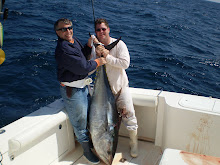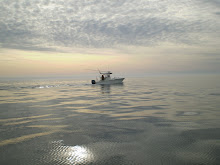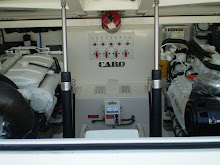
By Jim Field
On the subject of ship wrecks (see prior post on the USS Monitor), I thought I would put together a piece on the Dixie Arrow, which we oftentimes visit--right out of the gate--upon clearing Hatteras Inlet on the way to deeper water heading ESE on the compass rose. On a few visits, we've been very successful, catching dozens of triggerfish, sea bass, cobia (a "free gaff" courtesy of Dan)and other wreck dwellers. We've also seen swarms of amberjacks and the occasional huge shark. Conversely, on other visits we've come up short (that's fishing, right?). From a fisherman's perspective, the positive aspects of the Dixie Arrow are that it's relatively close to shore and in shallow water (say, 80'). The downsides are exactly parallel: close to land and shallow, which means that it's also a favorite dive site, which we suspect has something to do with lack of fish, the theory being that divers pick off fish of any value. (Note: we could be totally wrong about this; don't we all look to explain the inexplicable?)
 On the fishfinder, the Dixie Arrow presents a clear-cut, easy to find target. The ship's profile, nicely presented in the photo, wouldn't appear to support this: pretty flat except for front and aft houses. Of course, the ship, being a tanker, was deep-drafted and constructed of tons of hidden steel plate; it also sank violently, which means sections of it settled in a twisted heap.
On the fishfinder, the Dixie Arrow presents a clear-cut, easy to find target. The ship's profile, nicely presented in the photo, wouldn't appear to support this: pretty flat except for front and aft houses. Of course, the ship, being a tanker, was deep-drafted and constructed of tons of hidden steel plate; it also sank violently, which means sections of it settled in a twisted heap.Exactly how and why did the Dixie Arrow perish, and become, over 60 years later, a "tool" for the Crew? The following excerpt is from a really cool website, produced by the Association of Underwater Explorers, that charts all the wrecks off Hatteras Inlet--our fishing grounds!--and provides thumbnail sketches (upon click-command) of each doomed vessel. (Note: go to "Useful Links" in the right-hand column of this blog to access the website at "Ship Wrecks--Hatteras".)
 The Dixie Arrow was a 468' long tanker that was torpedoed off Hatteras, North Carolina, 26 March 1942, by the German submarine U-71. She remained afloat, purging crude oil, flames, and profuse quantities of black smoke, visible for miles. She eventually settled in 90' of water on a clean sandy bottom. The bow rises almost 30' off the bottom, with the skeletal frame intact for 80' until it breaks down into jumbled debris.
The Dixie Arrow was a 468' long tanker that was torpedoed off Hatteras, North Carolina, 26 March 1942, by the German submarine U-71. She remained afloat, purging crude oil, flames, and profuse quantities of black smoke, visible for miles. She eventually settled in 90' of water on a clean sandy bottom. The bow rises almost 30' off the bottom, with the skeletal frame intact for 80' until it breaks down into jumbled debris.  Anchor chain fills the bow space, with a hull plate holding a couple of portholes peeled off and laying in the sand below the portside quarter. There are deep washouts directly under the bow where copious supplies of seashells collect -- a great location for a malacologist. The main part of the wreck is a mass of twisted steel, though contiguous and with several landmarks. The three boilers, followed by the large engine are visible as one heads aft. Brass valves and an occasional gauge are found throughout this area. The stern boasts the bronze propeller, buried in the sand. About 60' off the starboard side of the stern, the remains of the superstructure lie half-buried in the sand. The Arrow is a popular wreck, home to several resident sea turtles and sand tiger sharks.
Anchor chain fills the bow space, with a hull plate holding a couple of portholes peeled off and laying in the sand below the portside quarter. There are deep washouts directly under the bow where copious supplies of seashells collect -- a great location for a malacologist. The main part of the wreck is a mass of twisted steel, though contiguous and with several landmarks. The three boilers, followed by the large engine are visible as one heads aft. Brass valves and an occasional gauge are found throughout this area. The stern boasts the bronze propeller, buried in the sand. About 60' off the starboard side of the stern, the remains of the superstructure lie half-buried in the sand. The Arrow is a popular wreck, home to several resident sea turtles and sand tiger sharks.I've put together recent photographs of her remains. Easy to see why we pick her up so well via sound waves.
Masts and jutting superstructure

Two of three huge boilers (engine in background)

The ship's engine

Decks, bulkheads, and chain


Look what's hiding--a toadfish

May she rest in peace. And....provide us lots of tasty treats!









No comments:
Post a Comment